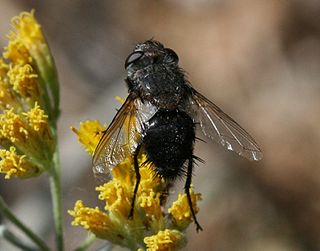
A black fly or blackfly is any member of the family Simuliidae of the Culicomorpha infraorder. It is related to the Ceratopogonidae, Chironomidae, and Thaumaleidae. Over 2,200 species of black flies have been formally named, of which 15 are extinct. They are divided into two subfamilies: Parasimuliinae contains only one genus and four species; Simuliinae contains all the rest. Over 1,800 of the species belong to the genus Simulium.

Chrysomya putoria, also known as the tropical African latrine blowfly, is a fly species belonging to the blowfly family, Calliphoridae.C. putoria is native to Africa and has recently spread to the Americas. These flies pose significant health risks, especially due to their close association with human settlements. Adult flies can carry pathogens, while larvae may cause myiasis by growing and feeding on the flesh of domestic animals and humans. Other myiasis-causing flies in the same genus are C. bezziana and C. megacephala. C. putoria and other flies that feed on decomposing tissue are used as important tools in forensic entomology to establish the post-mortem interval, or the time elapsed since death.

Chrysomya is an Old World blow fly genus of the family Calliphoridae. The genus Chrysomya contains a number of species including Chrysomya rufifacies and Chrysomya megacephala. The term “Old World blow fly” is a derivative of both the associated family, Calliphoridae, and the belief that the genus Chrysomya originated in Asia and migrated to North America only relatively recently. Chrysomya’s primary importance to the field of medico-criminal forensic entomology is due to the genus’ reliable life cycle, allowing investigators to accurately develop a postmortem interval. Chrysomya adults are typically metallic colored with thick setae on the meron and plumose arista. The name comes from the word chrysos, meaning “golden” in reference to the metallic sheen of the genus’ species, and -mya, a derivation from the word myia, meaning “fly”.

Acrocerinae is a subfamily of small-headed flies in the family Acroceridae. Their larvae are endoparasites of araneomorph spiders, with the exception of Carvalhoa appendiculata which can develop as ectoparasitoids on their host spiders. Traditionally, the subfamily included the genera now placed in Cyrtinae and Ogcodinae, but the subfamily in this sense was found to be polyphyletic and was split up in 2019.

Pseudogonia is a genus of flies in the family Tachinidae.

Siphunculina is a genus of small flies known as tropical eye flies. They are known for their habit of visiting the eyes of humans and other vertebrates to feed on fluids and in doing so cause annoyance, spread bacterial or viral diseases or cause injury to the eye. They have a habit of resting in large numbers on suspended strings, ropes and cobwebs.

Palpada is a genus of 85 neotropical and nearctic flower flies or hoverflies This genus is often colorful and bee-like. It is in the tribe Eristaliini containing dozens of genera Common sister genera include Eristalis (99 species), Meromacrus (43 sp.), Eristalinus (100 sp.) and Helophilus (50 sp.). The genus palpada is distinguished by:

The Ropalomeridae are a family of acalyptrate flies.

Philopotinae is a subfamily of small-headed flies. They have an arched body shape, as well as enlarged postpronotal lobes that form a collar behind the head. Their larvae are endoparasites of araneomorph spiders in the subgroup Entelegynae.

Panopinae is a subfamily of small-headed flies (Acroceridae). Their larvae are endoparasites of spiders in the infraorder Mygalomorphae.
Coquena is a genus of small-headed fly found in Argentina and Chile. It was first established by Evert I. Schlinger in 2013.
Pialea is a genus of small-headed flies. It is known from South America.
Ortalis is an historic genus of Ulidiid or picture-winged flies, first described by Fallén in 1810. It served as the type genus for the family Ulidiidae, which was called Ortalidae at the time. In 1932, it was pointed out by Adlrich that the name Ortalis was preoccupied by a genus of birds which had been named by Merrem in 1786. The name of the fly family was therefore revised, with some authors calling it Otitidae until Ulidiidae was settled on as standard. The genus itself was found to be paraphyletic, and all of its species have been reassigned to other genera, some in the Ulidiidae, and some in other Tephritoid families. In the following list, the species are organized according to the families and genera to which they have been reassigned.

Acrocera is a genus of small-headed flies in the family Acroceridae.

Ogcodes is a cosmopolitan genus of small-headed flies in the family Acroceridae. About 90 species have been described for the genus. It is the most common and speciose genus in its family. These flies are endoparasitoids of ground-dwelling entelegyne spiders.

Eulonchus is a genus of small-headed flies in the family Acroceridae. There are six described species in Eulonchus. The genus is found in North America. Adults have a metallic blue, green or sometimes purple coloration, giving them a jewel-like appearance. A common name for flies in the genus is the North American jewelled spider flies. Adults are also known as "sapphires" or "emeralds".

Turbopsebius is a genus of small-headed flies in the family Acroceridae. There are about four described species in Turbopsebius.

Sabroskya is a genus of small-headed flies in the family Acroceridae. It is known from South Africa and Malawi. It is named after the American entomologist Curtis Williams Sabrosky.

Cyrtinae is a subfamily of the Acroceridae. Their larvae are endoparasites of araneomorph spiders in the subgroup Entelegynae.

Psilodera is a genus of flies within the family Acroceridae. Members of this genus are found distributed in South Africa.















